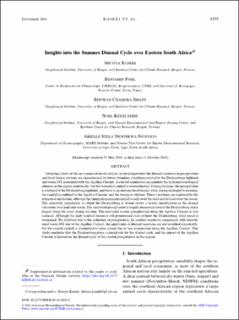Insights into the Summer Diurnal Cycle over Eastern South Africa
Koseki, Shunya; Pohl, Benjamin; Bhatt, Bhuwan Chandra; Keenlyside, Noel; Nkwinkwa Njouodo, Arielle Stela
Journal article, Peer reviewed
Published version

Åpne
Permanent lenke
https://hdl.handle.net/11250/2975816Utgivelsesdato
2018Metadata
Vis full innførselSamlinger
- Geophysical Institute [1198]
- Registrations from Cristin [9791]
Sammendrag
Adopting a state-of-the-art numerical model system, we investigate how the diurnal variations in precipitation and local breeze systems are characterized by lower-boundary conditions related to the Drakensberg highland and warm SST associated with the Agulhas Current. A control simulation can simulate the hydrometeorological climates in the region realistically, but the terrestrial rainfall is overestimated. During daytime, the precipitation is confined to the Drakensberg highland, and there is an onshore local breeze, while during midnight to morning, the rainfall is confined to the Agulhas Current, and the breeze is offshore. These variations are captured by the numerical simulation, although the timing of maximum rainfall is early over the land and delayed over the ocean. The sensitivity experiment in which the Drakensberg is absent shows a drastic modification in the diurnal variations over land and ocean. The terrestrial precipitation is largely decreased around the Drakensberg and is largest along the coast during daytime. The nocturnal marine precipitation along the Agulhas Current is also reduced. Although the daily residual breeze is still pronounced even without the Drakensberg, wind speed is weakened. We attribute this to the reduction of precipitation. In another sensitivity experiment with smoothened warm SST due to the Agulhas Current, the amplitudes of diurnal variations are not modified remarkably, but the coastal rainfall is diminished to some extent due to less evaporation along the Agulhas Current. This study concludes that the Drakensberg plays a crucial role for the diurnal cycle, and the impact of the Agulhas Current is limited on the diurnal cycle of the coastal precipitation in this region.